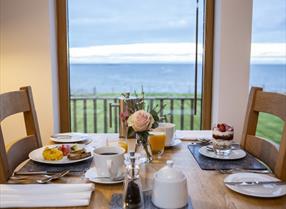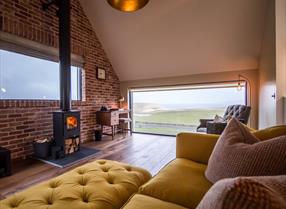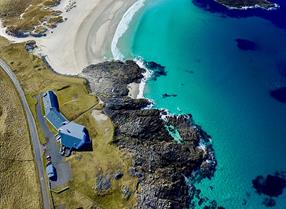For those of you who like to find out about a bit of local history when out and about on holiday, then it’s worth considering a visit to one of the lighthouses (taighean-solais in Gaelic) which guard the approaches to the Outer Hebrides, and have been doing so for up to two centuries.
Lighthouses in Scotland are the responsibility to this day of the Northern Lighthouse Board. If you are If you are passing through Edinburgh, the Board’s headquarters on George Street in the heart of the City is quickly recognised by a miniature working lighthouse, and it is also famous for being just about the only public body that still uses the original 1707 Union Jack on its flag (they are still considering an update). Prior to its establishment 1786, navigation around the islands was a treacherous affair. Changing this became the focus of the Board and of a dynasty of lighthouse builders from a single family - the Stevensons, who included the father and grandfather of Robert Louis Stevenson, the famous author.
The Board’s original remit was for four lighthouses, including one on Scalpay in the Western Isles, but the idea quickly caught on and four generations of Stevensons were the driving force behind Scottish lighthouses for over 150 years, starting with Thomas, Smith, followed by his apprentice and later son-in-law Robert Stevenson and then Robert’s sons and grandsons.
To help make it easy for you to locate them, we have partnered up with What3Words. This is a "fiendishly-clever” tool, that converts the entire globe into a series of three-metre squares, and names each square using a combination of three everyday words. This means that every part of the world has a unique combination. If you are in trouble, and you give those words your precise location comes up, no matter how remote your location - just like the Stevenson lighthouses were a 19th century safety innovation, this is a 21st century safety innovation. However it also saves time and avoids frustration when it is difficult to find a place because the address doesn’t help you know exactly where you need to be (if you are in a park, or on a beach, or where numbering is not systematic, unless you know the history - like some crofting townships in the Hebrides). You can give people the exact spot for their navigation devices, so if you are standing next to the tall central stone, nest to the chamber at the centre of the Calanais Circle, just tell people to go to ///necklace.losing.husband. They type it into the app and know where you are and how to get to you.
Wherever you are staying on the islands there will be a lighthouse not too far away. However, when placing them, little consideration was given to the road network many generations into the future, so, while some are on or just a short stroll from the road, others are a full-days hike, and a few are only accessible as part of a boat trip or on a yacht. Check out the one nearest you using the What3Words link. There are more details on Sarah Kerr’s blog, https://uklighthousetour.com/tag/outer-hebrides/. Sarah is the author of The British Lighthouse trail, with more details on the buildings, stories, locations and how to reach them.
Good for Walks
Eilean Glas - Scalpay, 1824. (///happening.ballroom.activates) One of the most popular walks in the Outer Hebrides with superb views back over Skye. The familiar red and white tower was constructed in 1824, but is on the site of one of the four original Northern Lighthouse Board beacons established in 1789.
Butt of Lewis - Rubha Robhanais, 1862 (///sleepless.replaces.require) At the very Northern Tip of Lewis, near the village of Ness, this 50m brick tower marks the very end of the road. Take a stroll along the impressive sea cliffs, wit the waves crashing on the rocks far below. It’s spectacular location makes it a popular spot for photographers.
Tiumpan Head, Lewis - Rubha Tiomphan, 1900 (///ship.quilting.cactus) A relative youngster, built in 1900, and short drive out from Stornoway through Point, this is one of the best places in Scotland for whale-watching. Look out for minke and humpback whales as well as dolphins.
Arnish Point, Lewis, 1853 (///fuzzy.regret.storeroom) This is less famous than the three previous towers, and more diminutive. It is located only a few miles out from the town of Stornoway, and for over 100 years, guided ships into the harbour, and makes for a nice walk if you are staying in the town. Nearby, bonnie Prince Charlie, spent a night laying low here in the protection of his supporters after his disastrous defeat at Culloden in April 1746. Looking for a means of escape, he failed to secure a vessel, but the good citizens of Stornoway also did not betray his whereabouts, despite a reward of £30,000.
Good for Boat Trips
Flannan Islands, 1899 (///frogs.emerald.newsprint) These islands are a popular boat trip destination from the West Coast of Lewis. Not long after the lighthouse was finished, the three keepers disappeared leaving no trace. To this day, no-one knows what happened to them and no bodies have been found. The obvious explanation that they were swept into the sea hasn’t stopped more exotic explanations. The story was recently made into a film called “The Vanishing” starring Gerard Butler. It is also famous for having the only railway in the Outer Hebrides, which was used to haul construction materials.
Shillay, Monach Islands, 1864 (///emperor.competing.poet) Like the Flannan Islands, the Monach Isles are a popular spot for boat trips and wildlife watching. Indeed the name of the island known in Gaelic as Sìolaigh, which is thought to derive from the Old Norse word for seal. 10 000 grey seals call the islands home. The original lighthouse here has been replaced by a more modern beacon, but was drafted back into service when its replacement proved that it wasn’t up to the job.
Barra Head, 1833 (///correct.quietest.triathlon) - The second oldest of the lighthouses, after Scalpay, you may get to see this during a boat trip to Mingulay or around th Barra Islands. It marks the southern entrance to the sits atop vast sea-cliffs, some 500ft high, which give you the opportunity in calm weather to travel through its natural sea-arch The island was inhabited until 1912, after which the lighthouse keepers only has the puffins for company. It’s a mile and a half up from the landing spot to the lighthouse.
Only For Real Adventurers
Milaid Point, Lewis, 1912 (///expect.rational.hiker) Despite being one of the younger Stevenson, towers, most of which remain in place, this one has been taken down, and replaced by a more modern construction. Only its platform remains. It is around a 5km trek across the moors, battling with Ushinish for the title of most remote. The Lochs region of Lewis is closely associated with the Clearances in the 19th Century, and on the other side of Lemraway, you can also visit the remains of the cleared village in Stiomrabhaigh.
Ushenish, South Uist, 1857 (///kipper.scribble.expect) ) A few miles across wild moorland from the end of the Loch Skipport Road (around 2.5hrs walk), at the top end of South Uist. One of the most scenic parts of South Uist, and once one of the main landing ports for steamers. The route is a mixture of marked track with open moorland in the middle. A remote but spectacular hilltop location.
North Rona, 1984 (//sticky.victor.hedgehog) The ultimate getaway (though not a Stevenson lighthouse), this is 45 miles from the nearest inhabited land. This island was home of a monk St Ronan an 8th Century Hermit, who thought Iona and all the other retreats were too busy and wanted ultimate isolation. Amazingly inhabited for several centuries it was abandoned in 1844. A medieval chapel still survives and 12th Century cross from Rona is displayed in the museum at Comunn Eachdraidh Nìs in Ness.













Comments
Comments are disabled for this post.